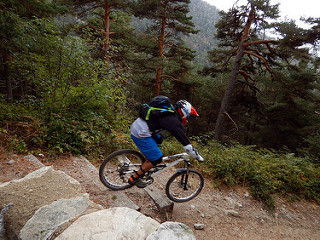Pablo does not approve.  He’s sittin’ over there passing judgement on my weeding skills. Like he can do better, he’s just a disembodied, floating wooden face with a disagreeable temperament.
He’s sittin’ over there passing judgement on my weeding skills. Like he can do better, he’s just a disembodied, floating wooden face with a disagreeable temperament. 
I guess I need to do some weeding, forthwith. 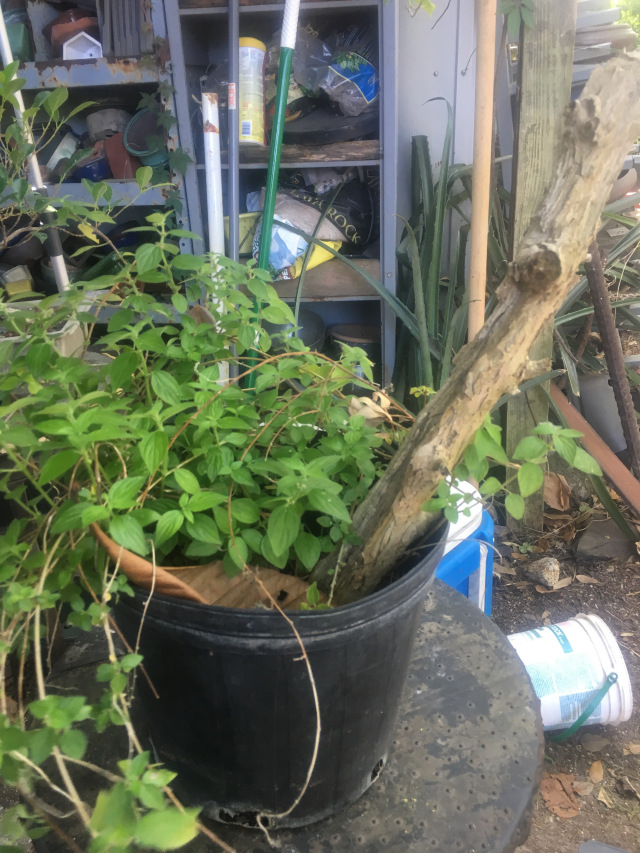 Or maybe he just doesn’t like the material I’m working on.
Or maybe he just doesn’t like the material I’m working on.
Half rotten….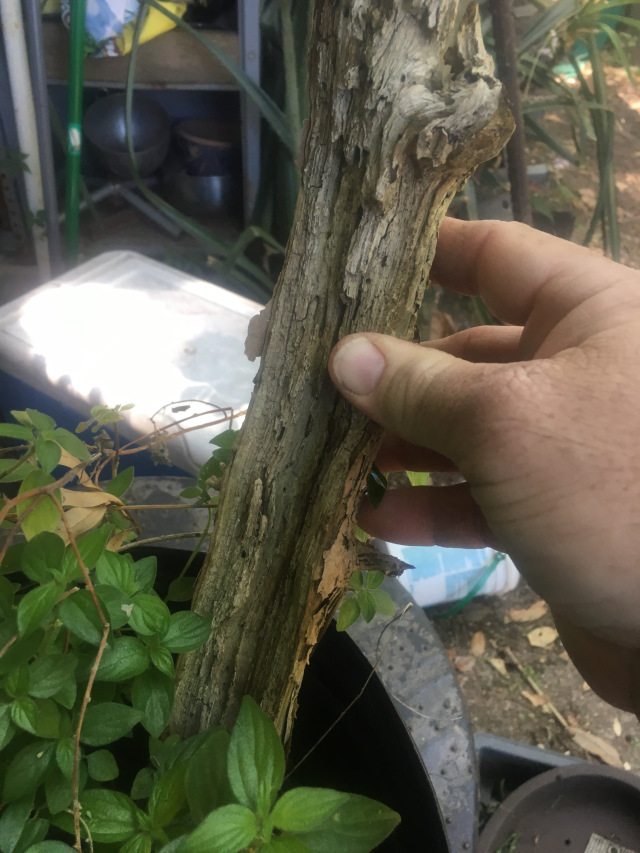
The leaves worm eaten and thin…..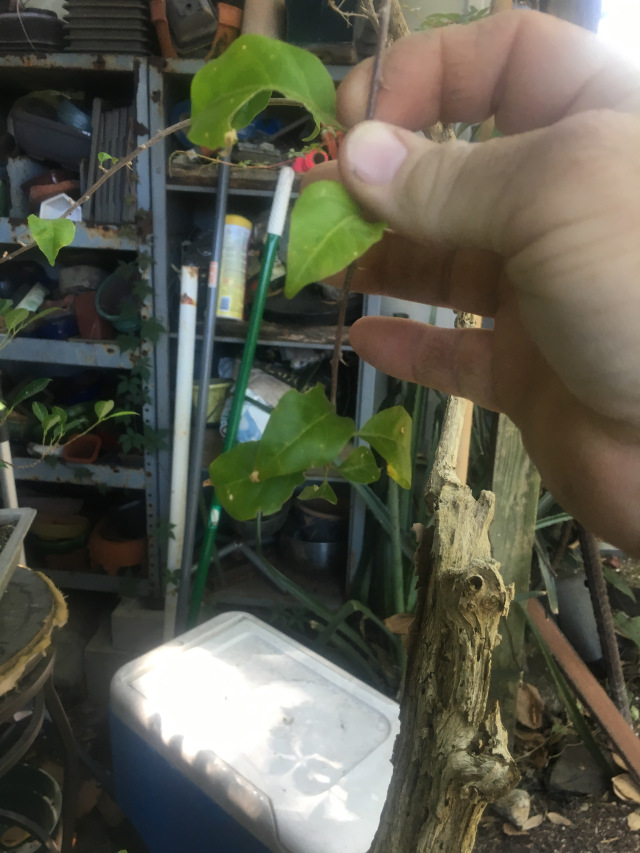 What is it?
What is it?
It’s a purple bougainvillea cutting I made maybe ten years ago.  I’d better get to those weeds….
I’d better get to those weeds…. I believe they are what’s called “Brazilian pusely”
I believe they are what’s called “Brazilian pusely”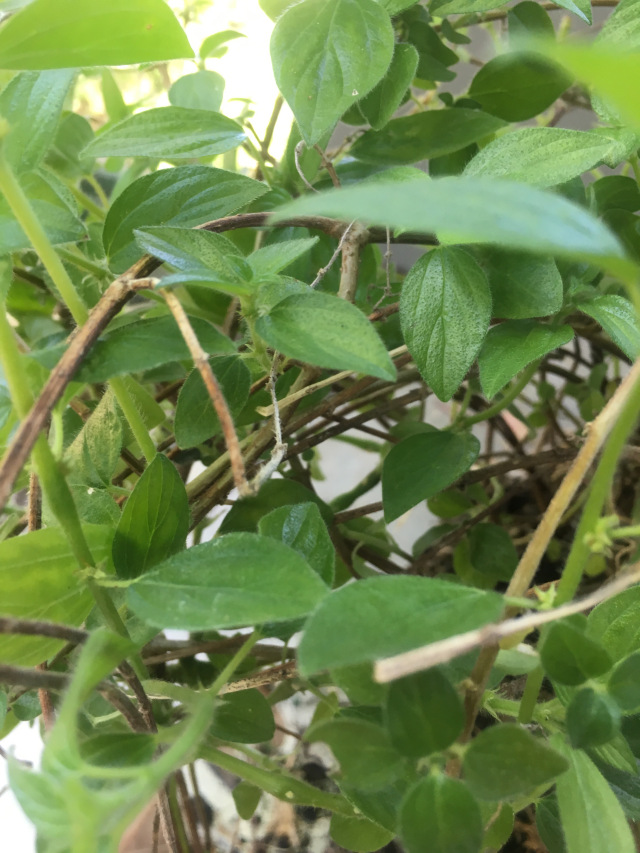 Or a whole bunch of common names like Mexican clover or Brazilian calla lily. There is a Florida pusley but there there are two differences, one, the fruit, and two, the roots. I don’t have a pic of the fruit at the moment but I can show you the roots.
Or a whole bunch of common names like Mexican clover or Brazilian calla lily. There is a Florida pusley but there there are two differences, one, the fruit, and two, the roots. I don’t have a pic of the fruit at the moment but I can show you the roots. 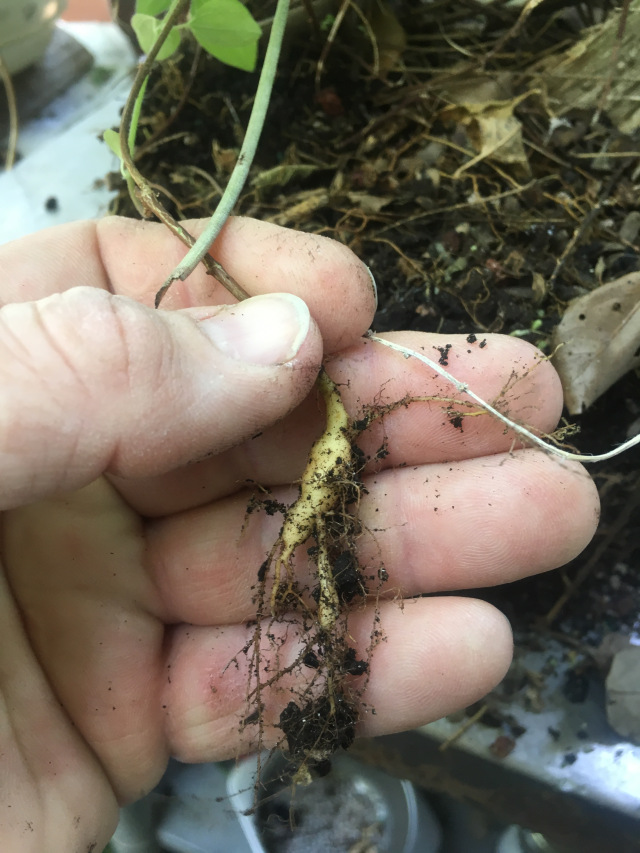
They’re reason I can identify this as the Brazilian pusley (richardia brasiliensis) and not Florida pusley (richardia scabra). 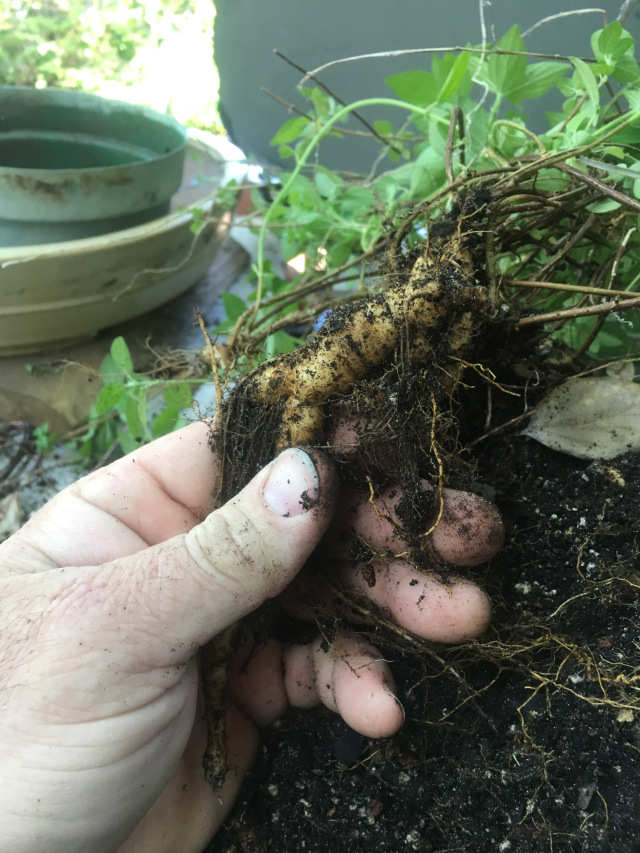 The Florida versions don’t have these tuberous root bodies.
The Florida versions don’t have these tuberous root bodies. 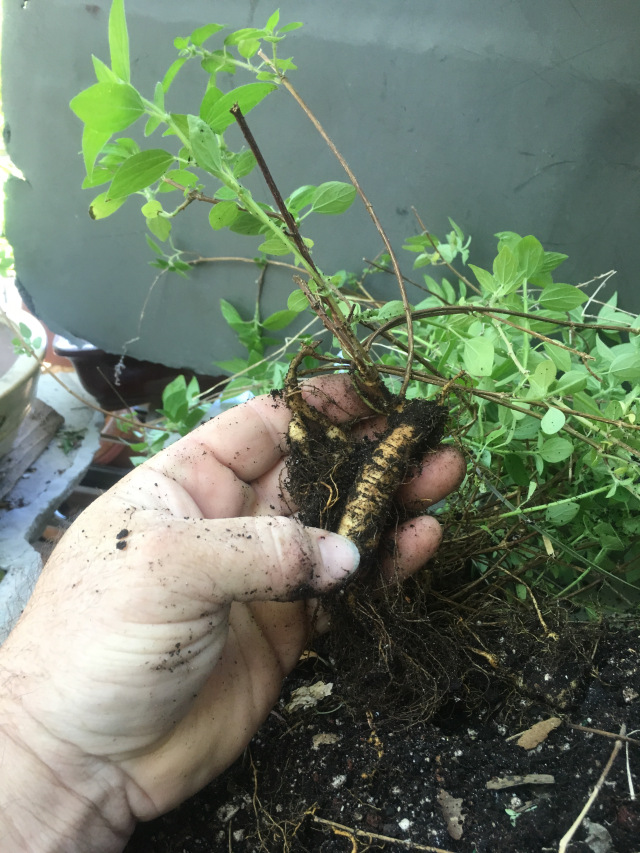 Control of the weed is difficult because of that tuber; if you pull the weed and don’t get all the root…..
Control of the weed is difficult because of that tuber; if you pull the weed and don’t get all the root…..
The damn thing will sprout back from what you left in the dirt. 
And glyphosate will kill the top but not the roots. I read through a full study on the control of this weed in orange groves in Florida and I learned some interesting facts. The Florida pusley was more prevalent in groves about 30 years ago and is considered an annual and was easily controlled with herbicides like glyphosate. But the Brazilian pusley has taken over the niche in the orange groves because of its resistance to the herbicides. And because of the shalllow footage of citrus it is damaging to the roots to dig out the Brazilian pusley tubers. So they stay. I, fortunately, am skilled at the removal of these tubers, and the tortoises love them.
There are some references to the pusley being a magnet or host for nematodes. I can’t find definitive citations for it so I’ll just leave that info their for future research. All I know is that there isn’t any nematode evidence on these bougie roots. Which is, I understand, a problem in Florida for a bougie, but I’ve never had it on one of mine….yet. 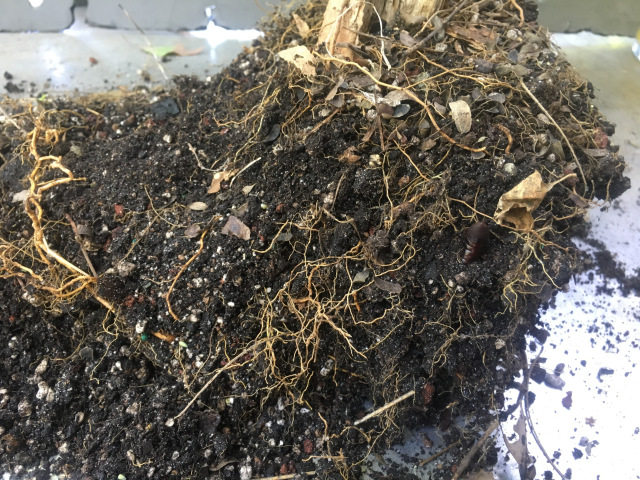
Before I put it into a pot, let’s look at the trunk. 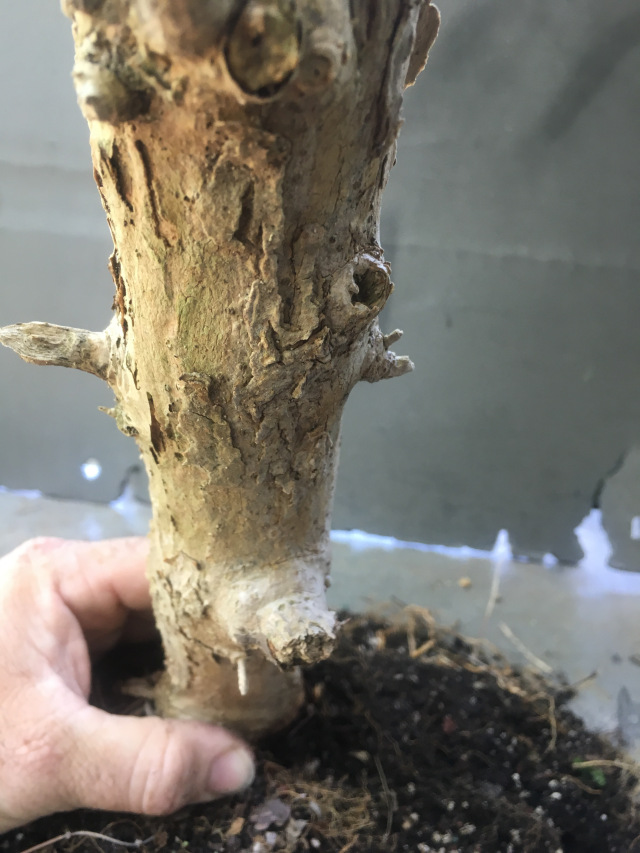
It is half rotted away, I need to carve it and my carving tools of choice today are, a wire brush….
And my fingers. 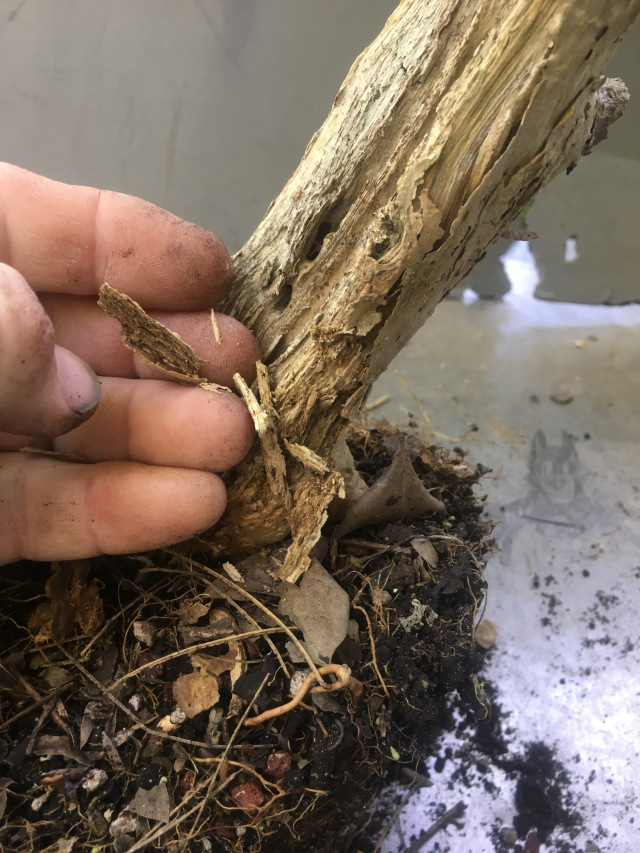
The fingers break off the most-decayed parts. Easy.
The brush reveals the grain. 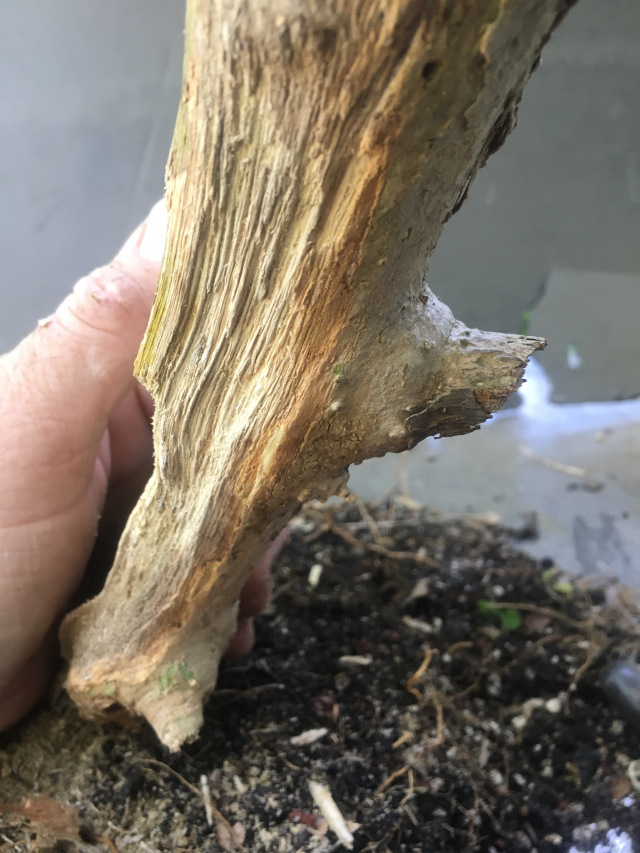 Purty cool.
Purty cool.
I had to break out the old pocket knife to evict some ants. Do you see them? 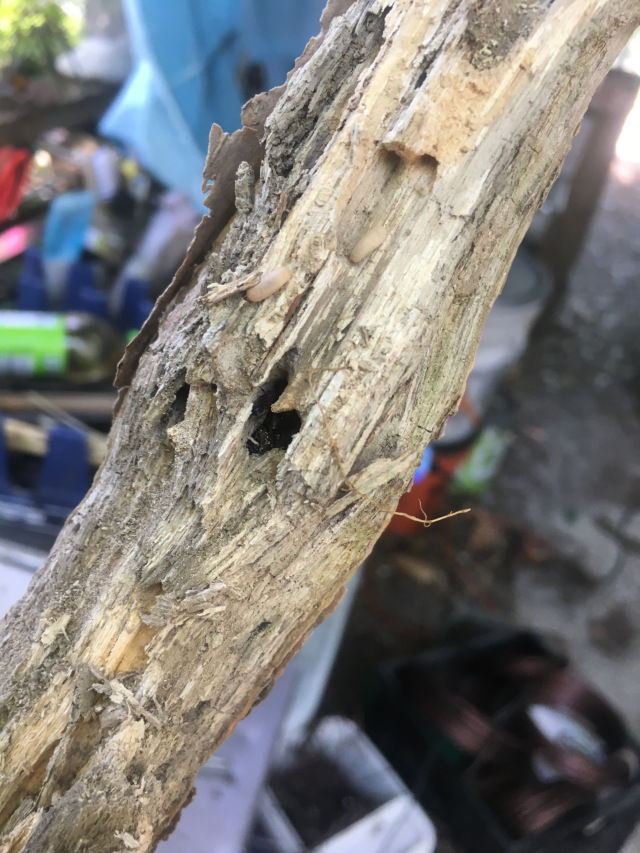
There they are!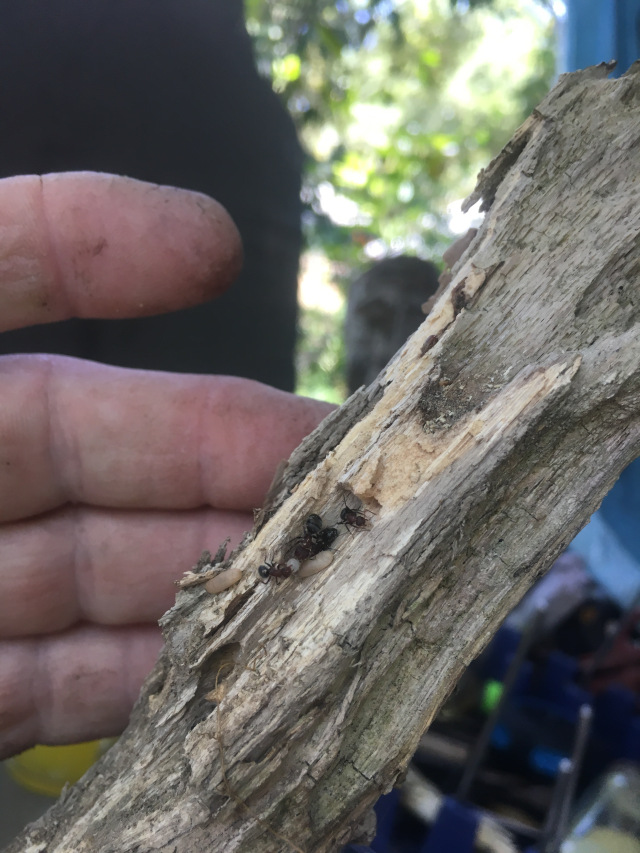
So long my little collectivist friends….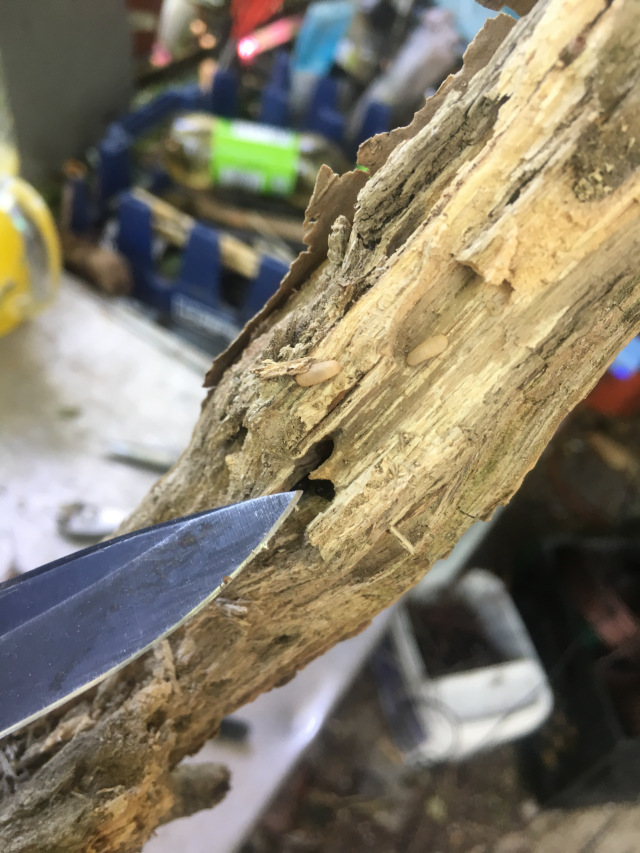
The reason I addressed the wood cleaning first was to protect the roots from the damage that all that carving movement causes. A bougie cutting takes a long time to make good rootage that’s thick enough to be considered a nebari (in English, that’s what the botanists call the buttress. Probably a better word as that brings to mind a swollen bottom portion of the tree, but we use Japanese often in bonsai) and I didn’t want brakage.
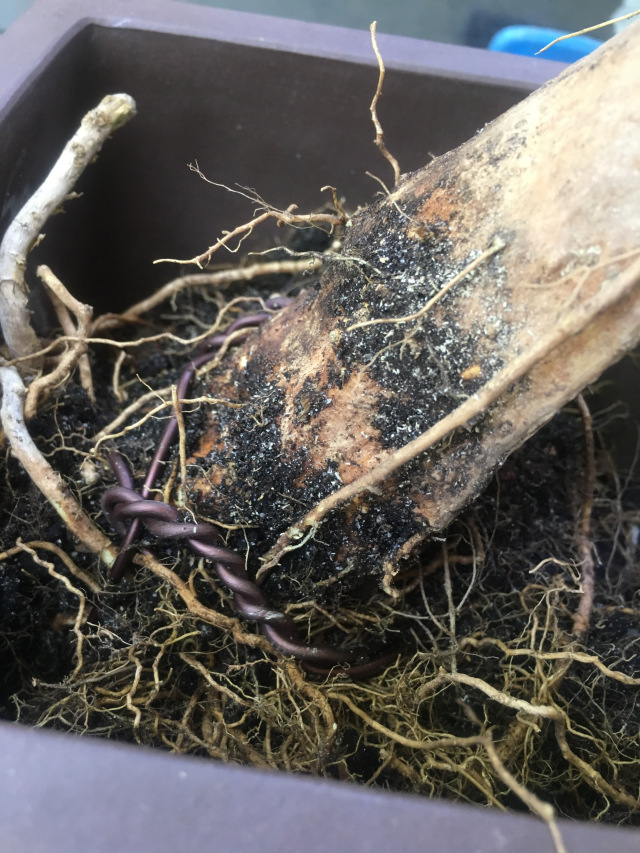 See, not much to look at and terribly fragile (like me and my ego)
See, not much to look at and terribly fragile (like me and my ego) 
As I brush this deadwood, especially on a bougie, it’s in my best interest to wear a mask.  Scary! It is a fungus that causes the wood to rot, after all, and we don’t need fungus in the lungs.
Scary! It is a fungus that causes the wood to rot, after all, and we don’t need fungus in the lungs. 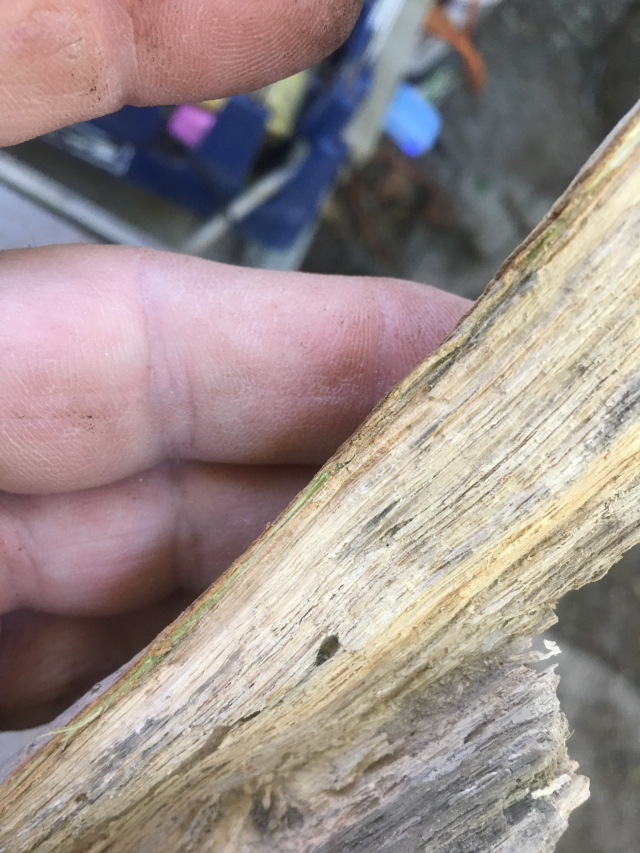 There we go.
There we go.  I will treat with lime sulfur in a few weeks, not for color but to kill that fungus.
I will treat with lime sulfur in a few weeks, not for color but to kill that fungus.
Now for the pot. I’ll go traditional I think. A nice square one, commissioned from the most non/traditional bonsai guy himself, Robert Stevens, for the 2009 BSF convention. 
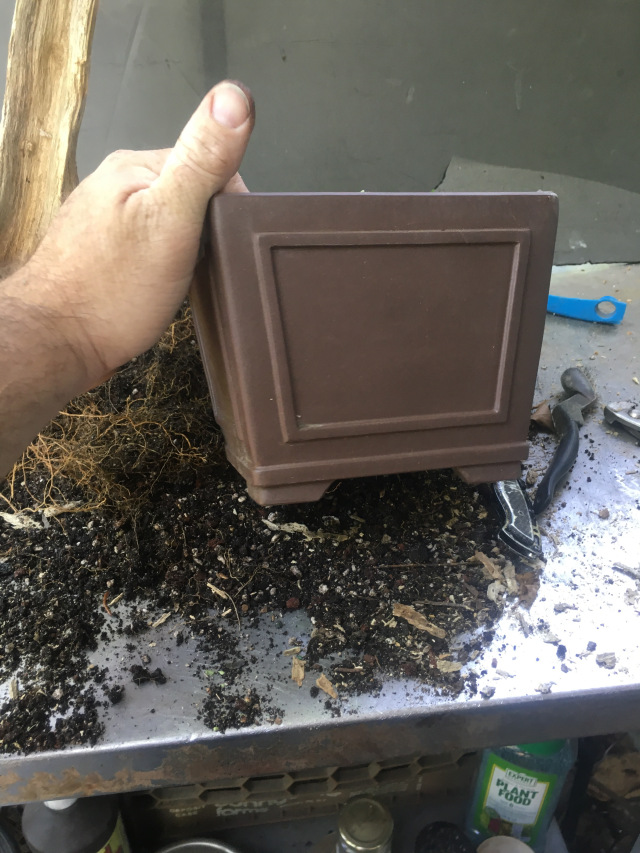
Because the bougie is a cutting and has very few roots, I’ll need a rock to build this tree upon. 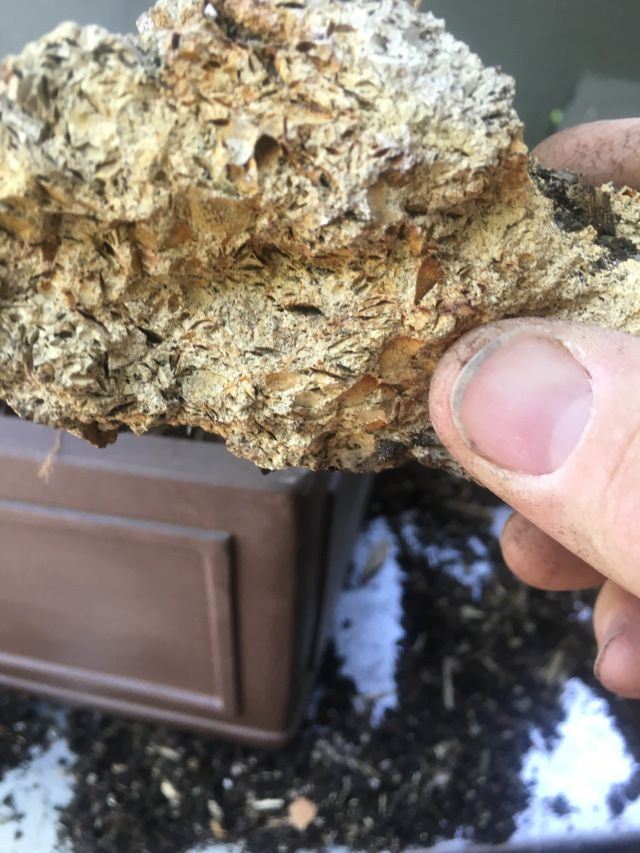
Or at least to lean upon. 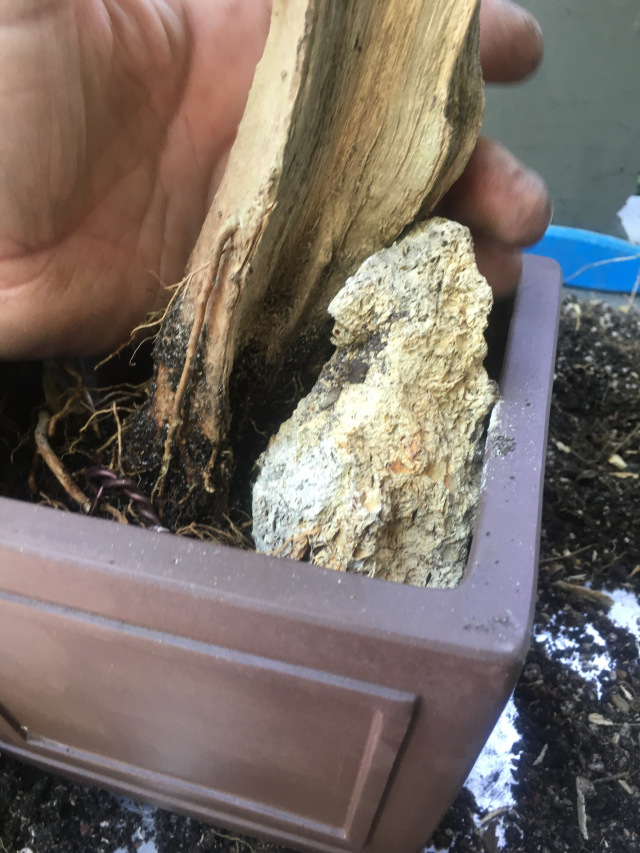
That’ll do, that’ll do. 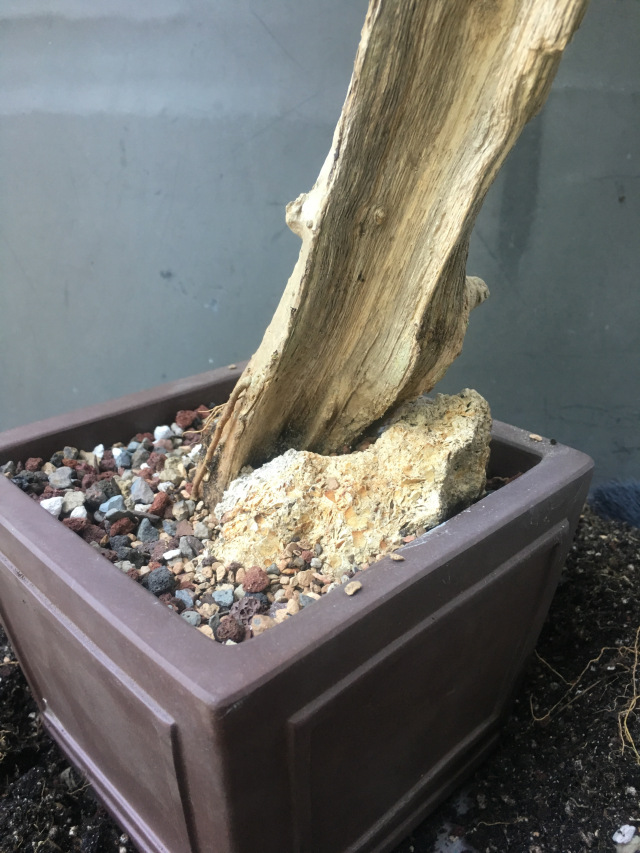 This tree, as I said, is a cutting. About 7-8 years ago I collected a big trunked bougie and rooted a bunch of cuttings off of it. I was bored I guess. The main collected trunk I gave to my friend, Erik Wigert, at Wigert’s Bonsai, mainly because he is the best bougie bonsai artist in the USA. He’s no slouch with other trees, mind you, but his work with bougie has made other artists reconsider the possibility of the species for superior ramification, branching, structure and, most importantly, horticulture. Here’s the tree I gave him, pic from December 2015:
This tree, as I said, is a cutting. About 7-8 years ago I collected a big trunked bougie and rooted a bunch of cuttings off of it. I was bored I guess. The main collected trunk I gave to my friend, Erik Wigert, at Wigert’s Bonsai, mainly because he is the best bougie bonsai artist in the USA. He’s no slouch with other trees, mind you, but his work with bougie has made other artists reconsider the possibility of the species for superior ramification, branching, structure and, most importantly, horticulture. Here’s the tree I gave him, pic from December 2015:
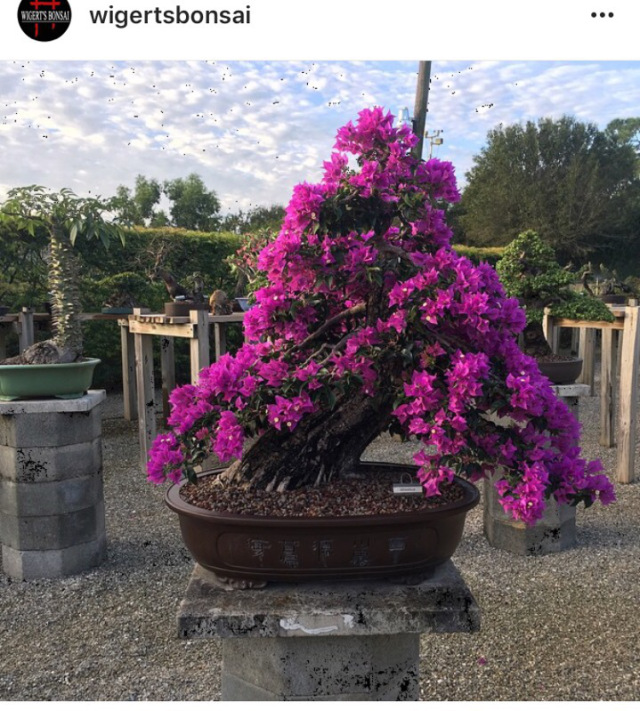 He is on Instagram, go follow him.
He is on Instagram, go follow him.
The tree again, this time defoliated, from August, 2015: He achieved that structure in 5-6 years. What would take 20-30 yrs on other trees. Amazing.
He achieved that structure in 5-6 years. What would take 20-30 yrs on other trees. Amazing.
Now, there are some who criticize his traditional pine tree styling of a broadleaf evergreen, but, you know what, first, bonsai is an art, and a bougie is one of those species that are, what I term, a plastic tree. Meaning, in the original definition of the word plastic, malleable. Some other trees I consider plastic are junipers, some elms, trident maples, most ficus, pines, etc. What I mean is that they can be styled in various tree forms (pine tree, deciduous, banyan, live oak, cascade) because the natural growth habits are not that strong and, therefore, not fighting you. Conversely, it’s tough to make a cascade swamp maple because the bottom branches want to die back. But you can make a cascade bougie. Or a live oak tree style juniper. Or a pine tree style elm.
Secondly, they are his trees, and this is his “style”. How many bonsai artists are there in the world who can boast that their style is recognizable? Not many.
Thirdly, I think it’s just jealousy. Erik has developed his own way of doing things and he does it well. Better than most everyone else who might criticize him. And I’ll leave it there (Although I might shorten the bougie a bit….myself……sorry Erik. Heeheehee!)
Now, ladies and gentlemen, the main event! Time to wire!
Some establishing shots: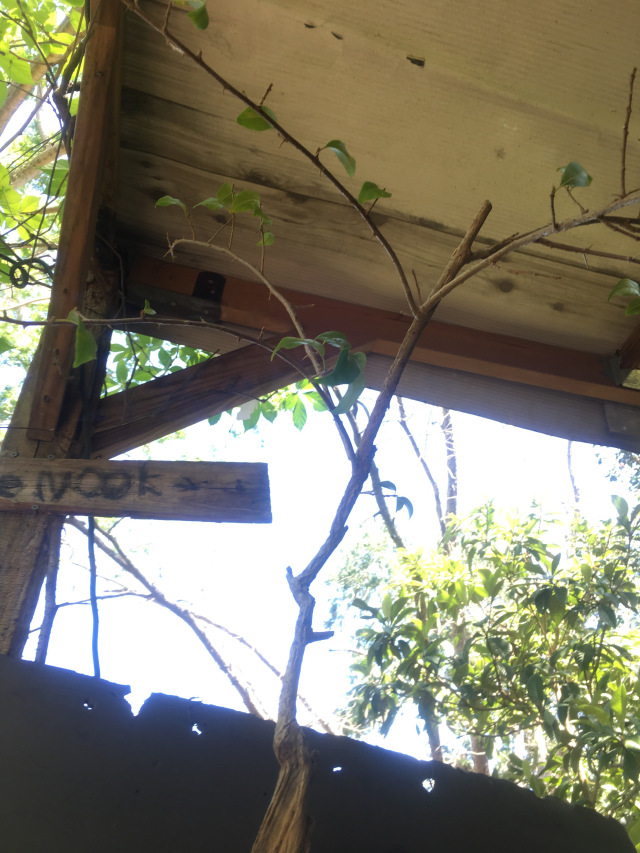
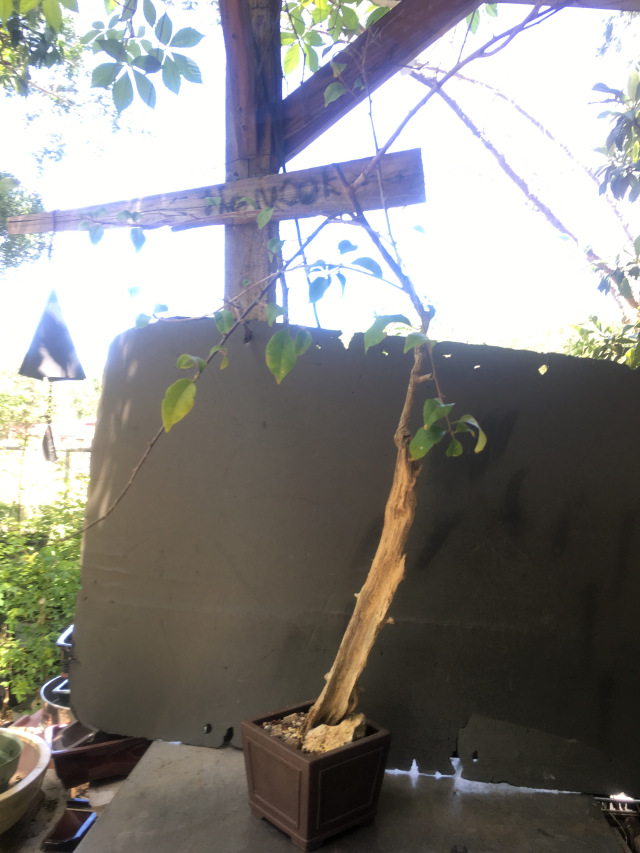
I need to bend these lengths.  I’d say the top is about 1/2″ thick and the next length is about 1/3″ thick
I’d say the top is about 1/2″ thick and the next length is about 1/3″ thick 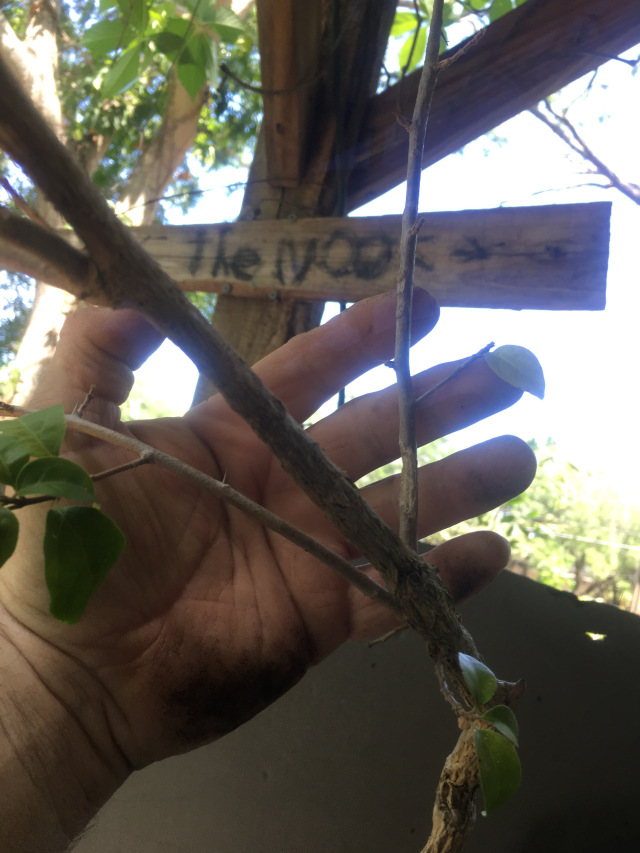
The weakest part of the whole tree is where the dead trunk meets the upper living potion of the tree. 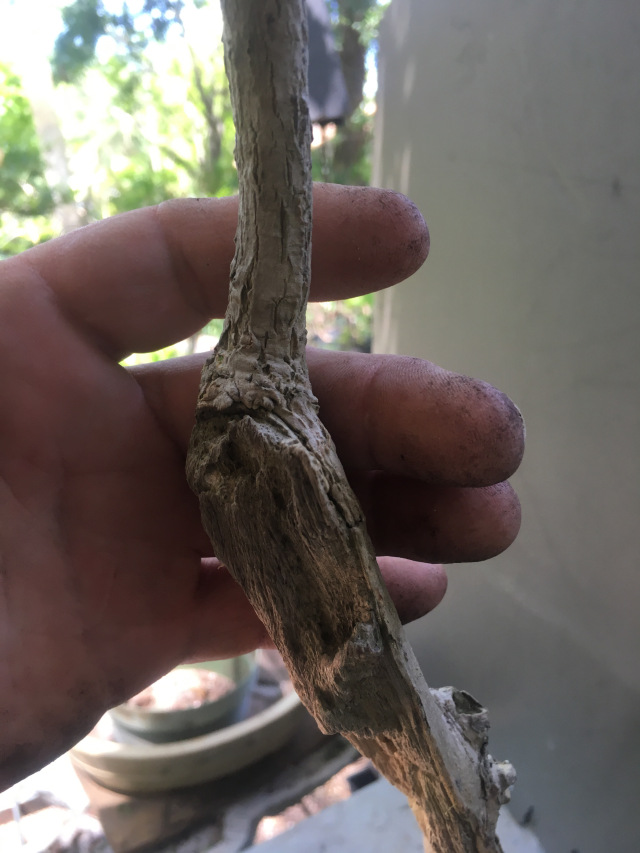 That means I’ll need to wrap the wire around the deadwood. Not my first choice but you gotta make it work before you make it pretty.
That means I’ll need to wrap the wire around the deadwood. Not my first choice but you gotta make it work before you make it pretty. 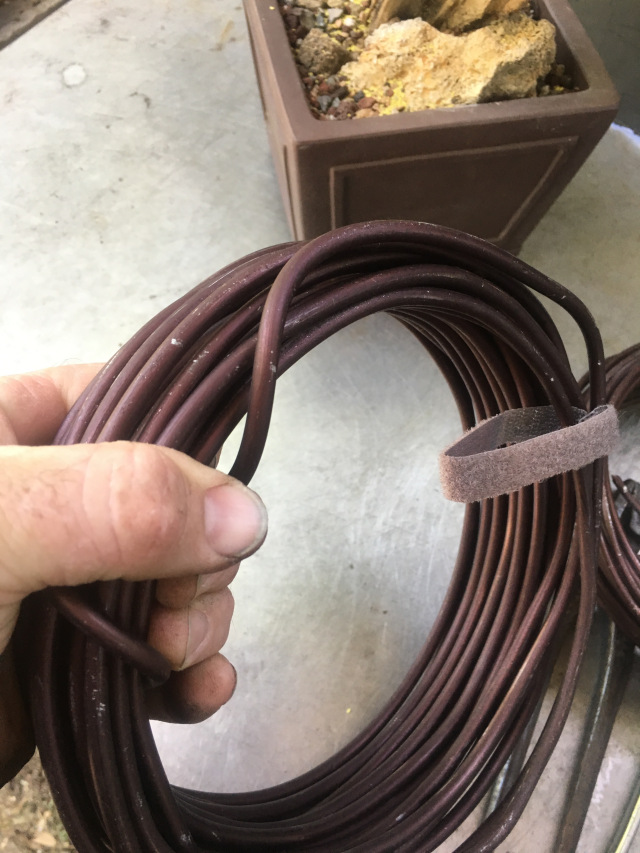 I think it’s 5mm aluminum.
I think it’s 5mm aluminum. 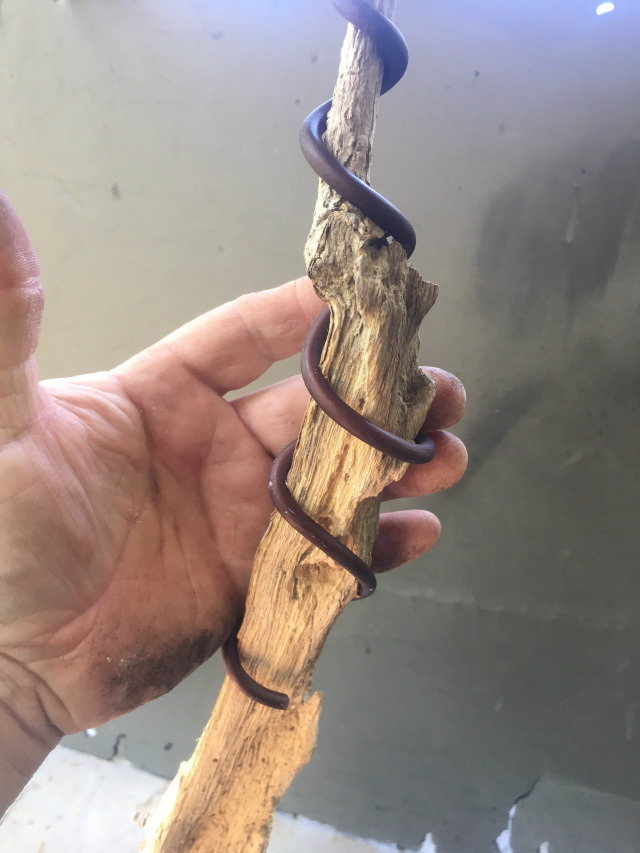 It makes a difference which way you wrap the wire as to which way you bend the branch.
It makes a difference which way you wrap the wire as to which way you bend the branch. 
I’ll be going to the right and twisting the branch clockwise, so my wrap goes clockwise as well. The angle of the wire on the branch makes a difference too. Where the bend is going to be less severe, your angle should be more acute (if you layed a protractor with the flat side running along the branch, the angle might be 30-40 degrees). If your bend is going to be more severe, you angle it at 45 or more. This gives better coverage and less chance of breakage) 
Ready for the bend? Cross your fingers! 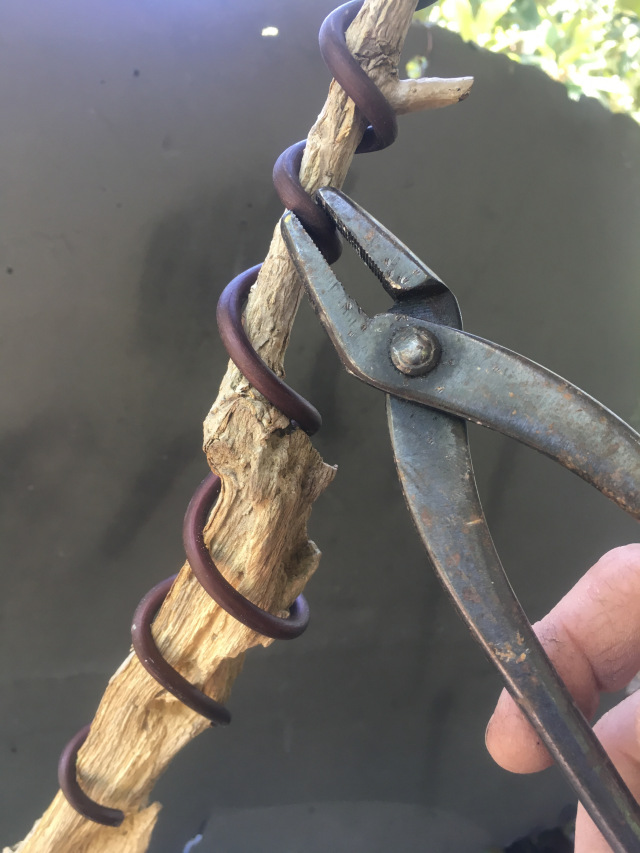 What works, in the absence of a branch bender, is to use the wire and pliers to help with leverage.
What works, in the absence of a branch bender, is to use the wire and pliers to help with leverage. 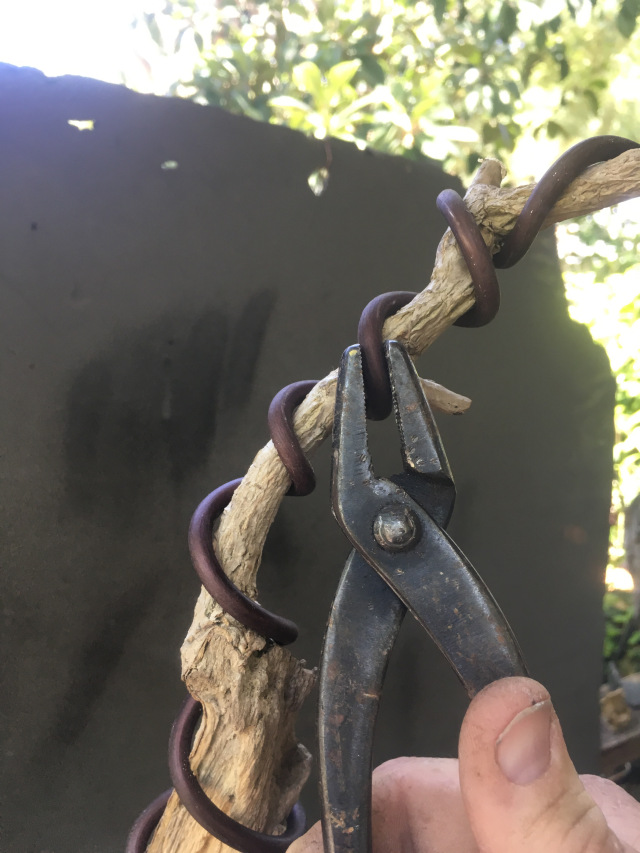
As I bend I make sure to listen and to keep an eye on the outside edge of the bark. 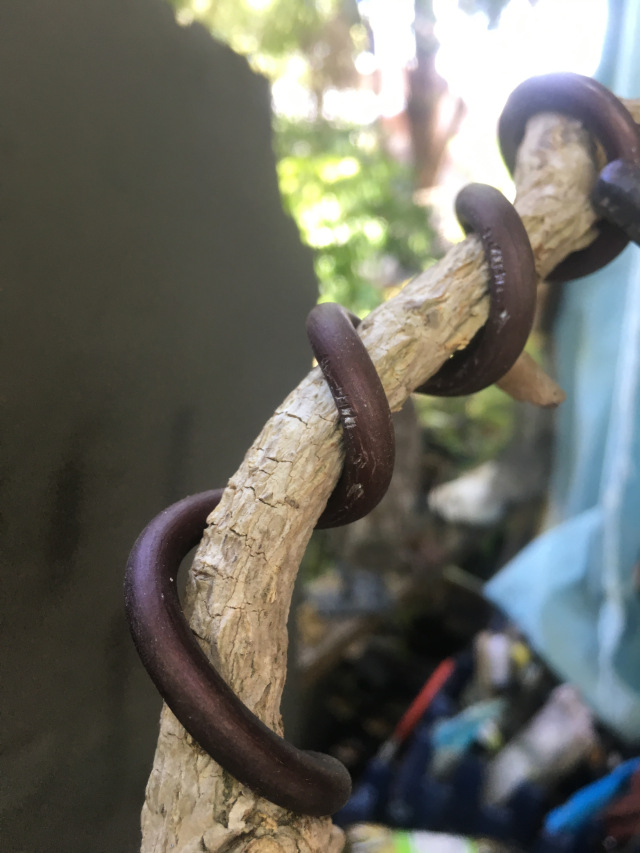 Those cracks above on the bark are ok, you can even expose some of the green underneath. Just be careful of deeper cracks that appear beyond the cambium later.
Those cracks above on the bark are ok, you can even expose some of the green underneath. Just be careful of deeper cracks that appear beyond the cambium later.
First bend.
 As you continue the bends further up the trunk, you can go back to increase the earlier bends. The stress on the bark lessens over time as you are working on the tree. Just don’t over do it.
As you continue the bends further up the trunk, you can go back to increase the earlier bends. The stress on the bark lessens over time as you are working on the tree. Just don’t over do it.
Continuing. 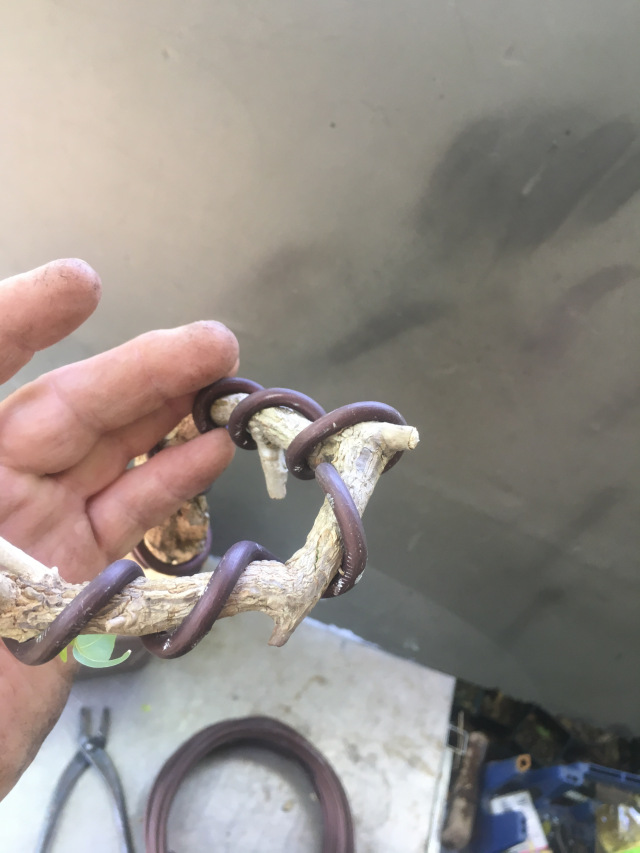
Around. 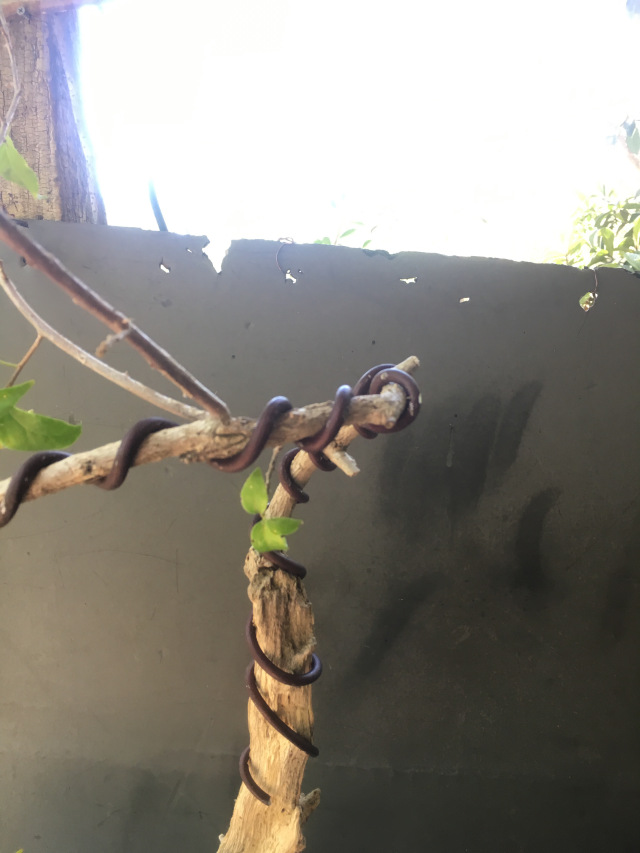
Down. 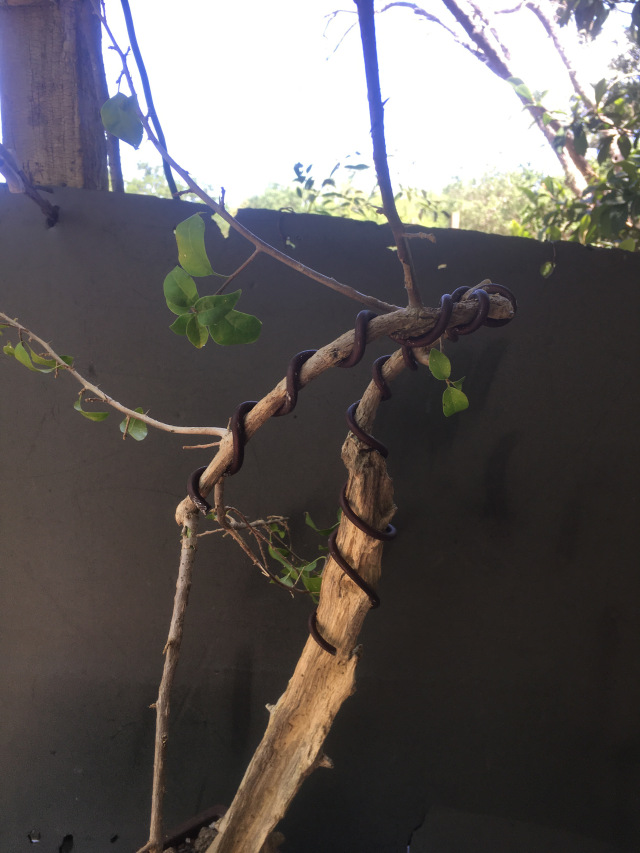 And I just cut the height in half. Without a single cut.
And I just cut the height in half. Without a single cut. 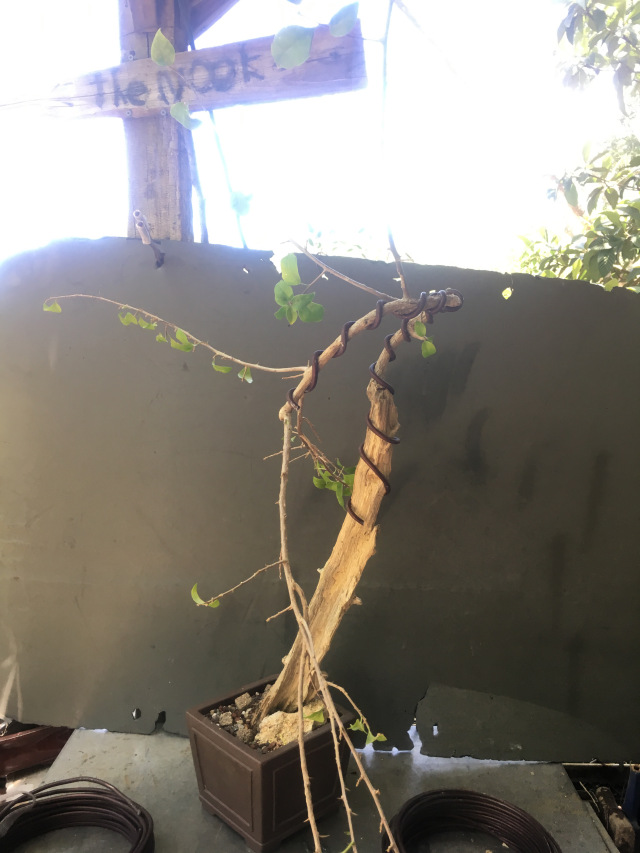 So you don’t have to scroll up, the before:
So you don’t have to scroll up, the before: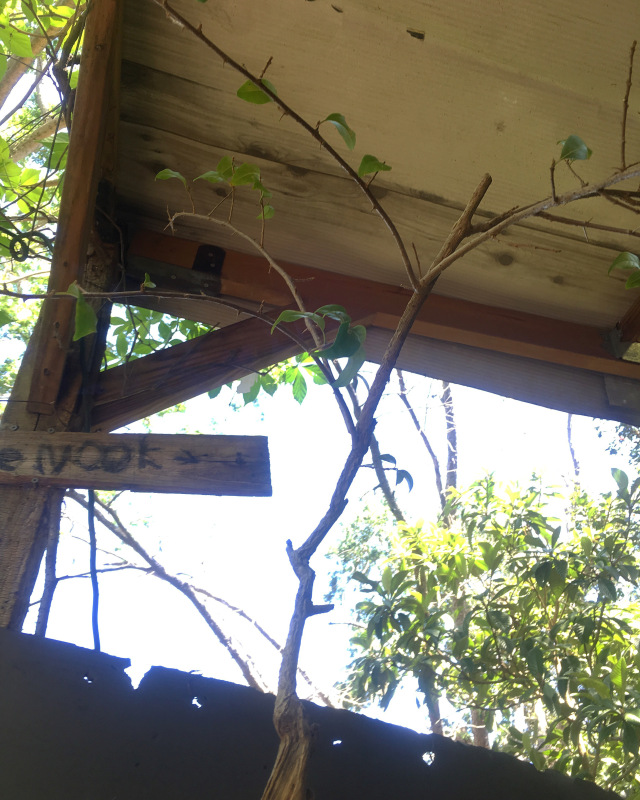 …….it was touching the roof of The Nook, now it’s touching the bench.
…….it was touching the roof of The Nook, now it’s touching the bench.
Some more wire. I should note that it’s a dangerous thing to work with bougies, this one has small thorns, but that makes them stealthy. 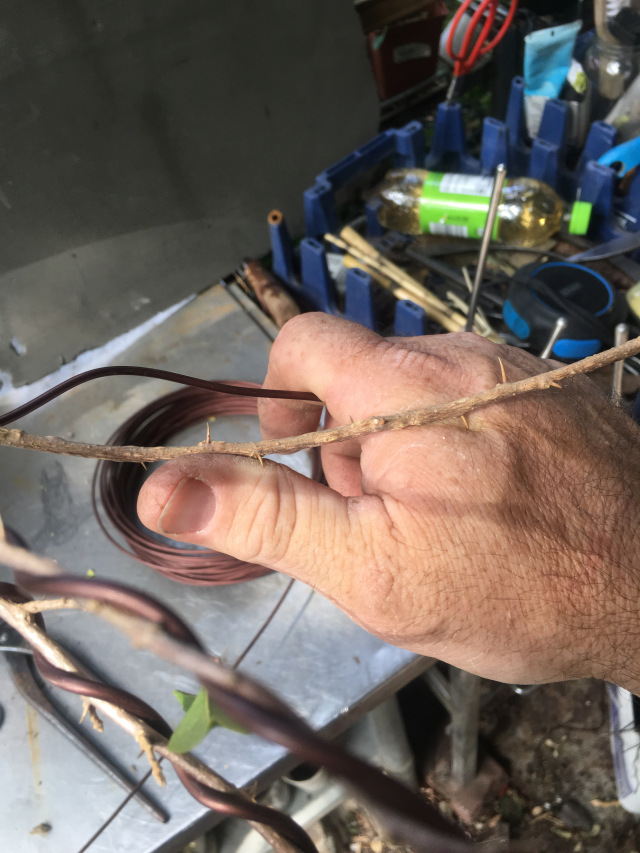 I mean, damn, I’m bleeding all over!
I mean, damn, I’m bleeding all over! 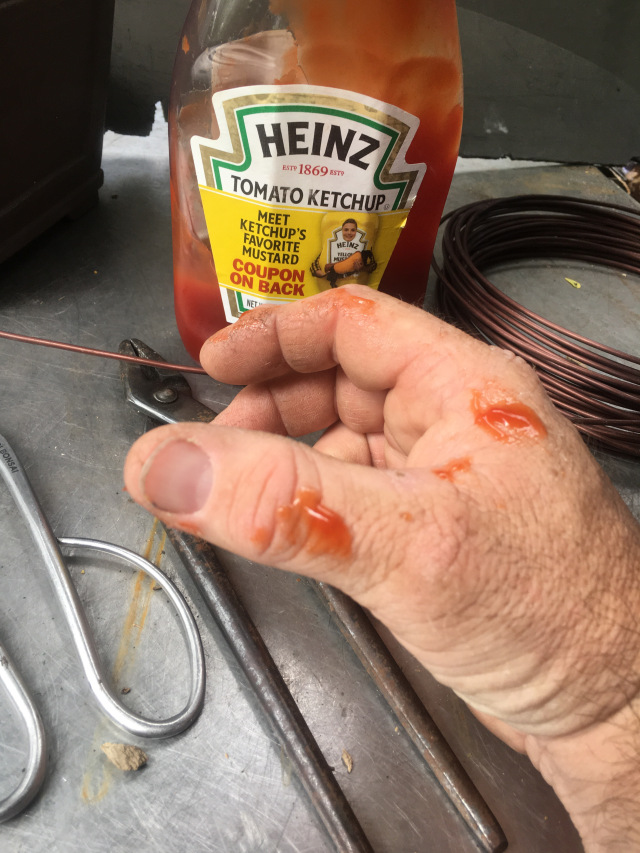 Sorry.
Sorry.
Every branch…..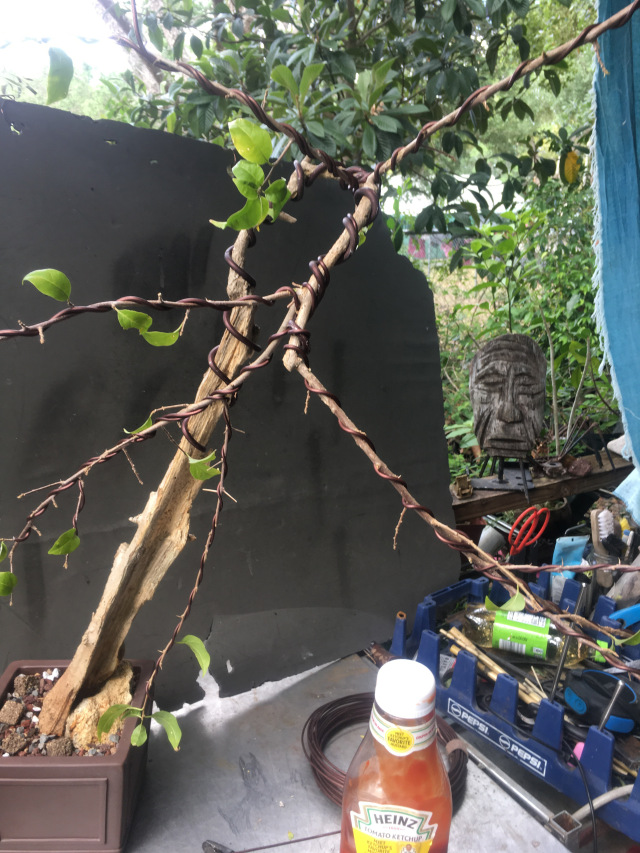
In the next pics you can see the various wire coil angles I was talking about….. …..some of the anchoring techniques I’ve discussed in previous posts……
…..some of the anchoring techniques I’ve discussed in previous posts……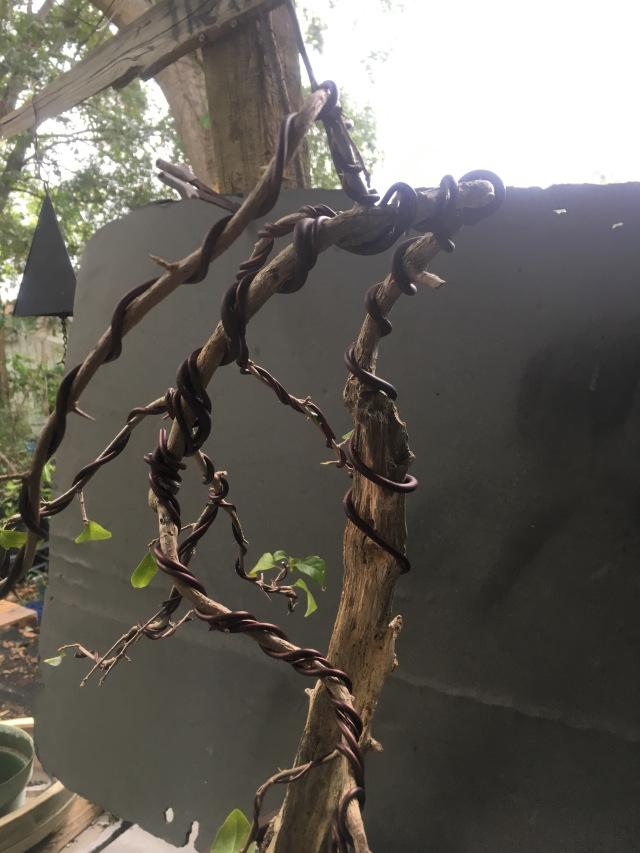 …..as well as the placement techniques.
…..as well as the placement techniques. 
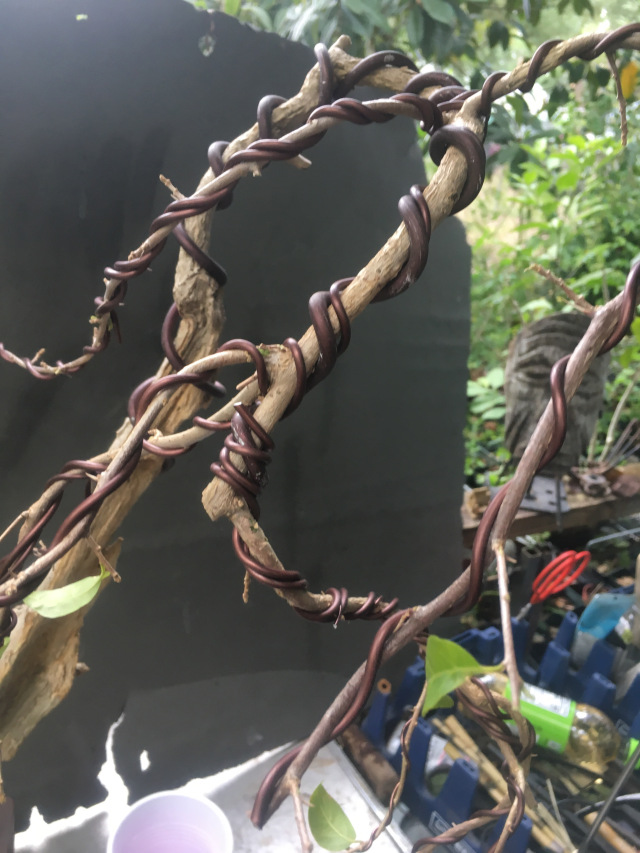
Are you ready for the whole tree?
Yeah?!
Too bad, let me talk about the aesthetic ideas I’m trying to express with a bougie like this.
I’m taking my visual cues from the treatment of the Japanese ume (prunus mume) variously called the Japanese plum or apricot. I won’t steal any photos from the internet to show you the idea of a rotten or withered trunk on the ume, just look up “ume bonsai” on the google machine thingy (in today’s digital age, it’s easy to get sued for using a pic without permission, and I ain’t got the money to defend myself, sorry). I’ll wait until you get back (you can go to Bonsai Tonight and this page in particular for some interesting ume)………
Are you back? You see now how the flowers and the rotten trunks are a sweet and sour contrast? I can’t grow ume in Florida, but I can grow bougies, so it’s been my goal to develop a style of bonsai using the old trunks I’ve been saving. Here’s one you might recognize: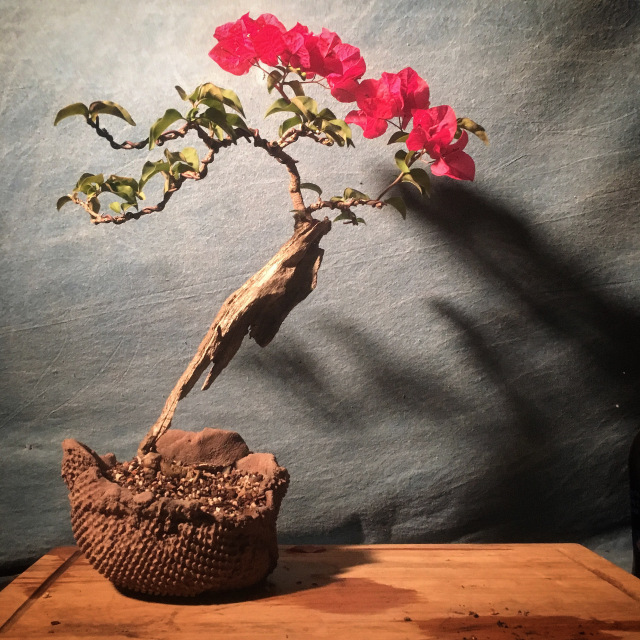
Here’s one I just styled: 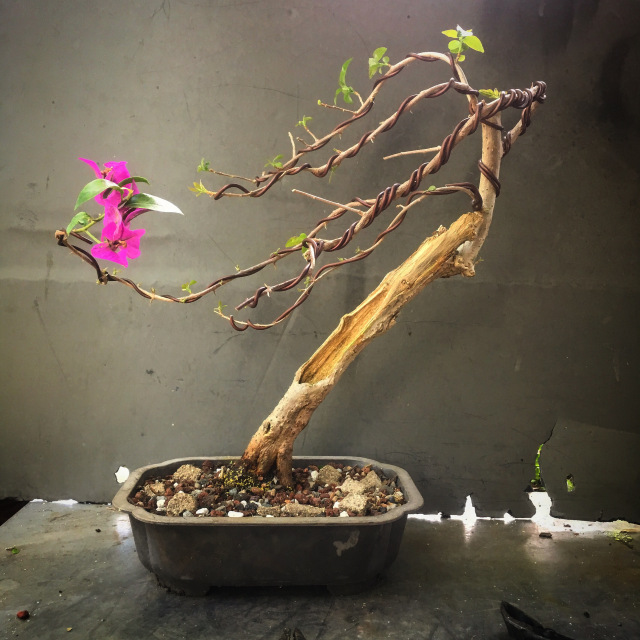
This one is on the bench for tomorrow: 
And a future subject of a YouTube video.
Now, granted, the bougie doesn’t have the cultural, culinary, and even medicinal significance that the ume has in Japan (though it’s quite ubiquitous in the warmer parts of the world and has an ethos all its own) but the Art we practice is mainly visual, and the contrast between the ephemeral, and decayed nature of the withered trunk and the flaming beauty of the bougie bloom does make for a bold, but still subtle, statement about bonsai and the question of making Art out of living things.
Are you ready for the reveal or have I made you click off the page with my talk of philosophy and Art?
For those of you left…..or who scrolled past without reading….
The left-ish side……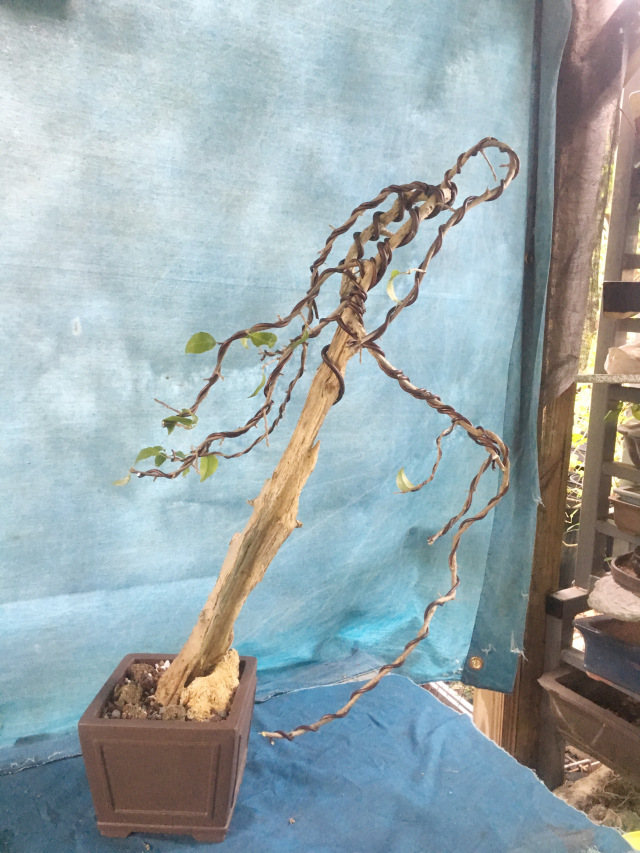 Being in a square pot is almost the same as being in a round pot.
Being in a square pot is almost the same as being in a round pot.
The right-ish side……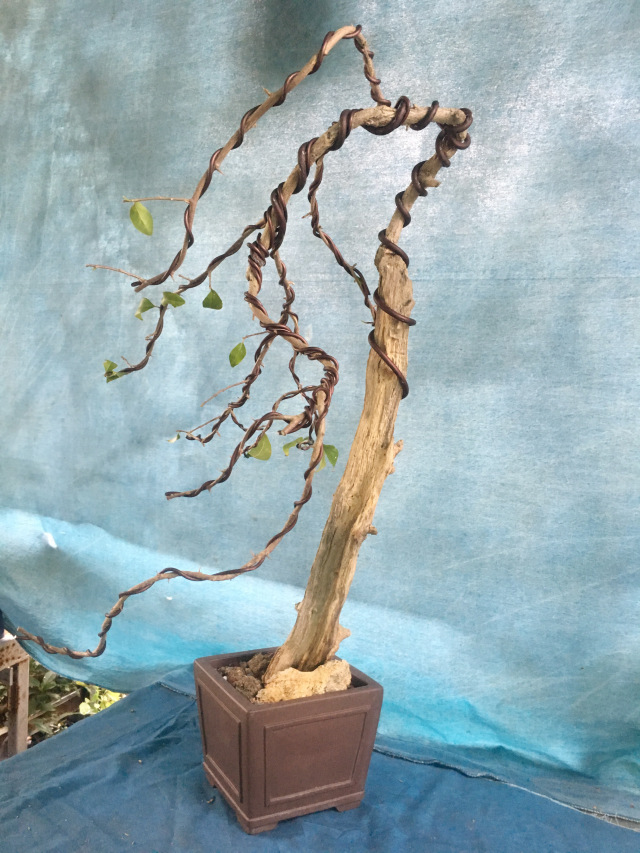 It means the front is a larger arc than say the front of the tree in an oval or rectangle pot.
It means the front is a larger arc than say the front of the tree in an oval or rectangle pot.
And my current front. 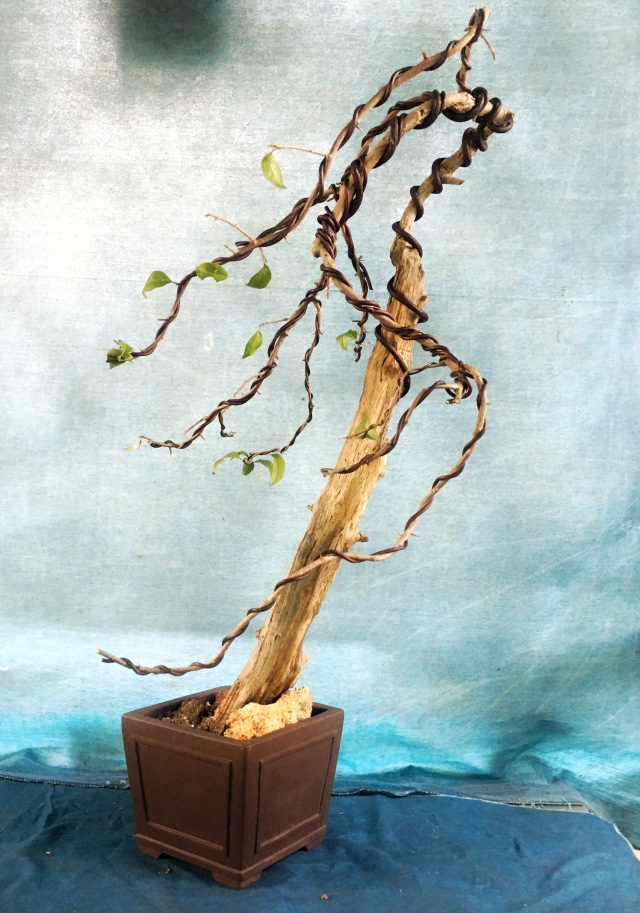
I think it turned out well.
So, whether you think I’m crazy for working on material like this, which might die in the next windstorm (but, don’t they all have the possibility of dying?) or crazy like a fox for trying to sell a piece of marginal material (I might note that the pot is a collectible and therefore the tree is not for sale) that’s been taking up space on the benches, you gotta admit it looks cool, don’t you? Wait for it to bloom!
That’s all for today, I’ve got to go outside and work on some trees, I’ve been traveling way to much recently and the nursery is suffering from it……toodles!
Share this:

